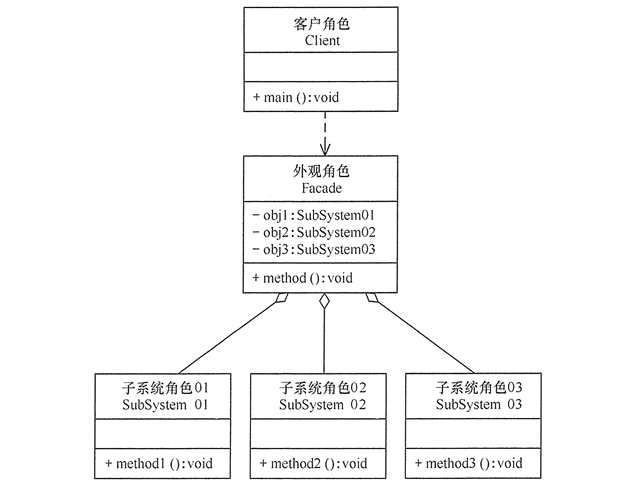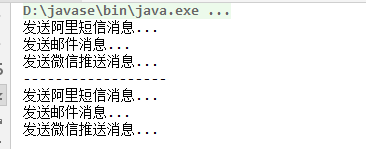设计模式【6】------>外观模式
一、什么是外观模式
- 外观模式:也叫门面模式,隐藏系统的复杂性,并向客户端提供了一个客户端可以访问系统的接口。
- 它向现有的系统添加一个接口,用这一个接口来隐藏实际的系统的复杂性。
- 使用外观模式,他外部看起来就是一个接口,其实他的内部有很多复杂的接口已经被实现
二、外观模式结构
- 外观(Facade)角色:为多个子系统对外提供一个共同的接口。
- 子系统(Sub System)角色:实现系统的部分功能,客户可以通过外观角色访问它。
- 客户(Client)角色:通过一个外观角色访问各个子系统的功能。
结构图

三、外观模式例子
- 用户注册完之后,需要调用阿里短信接口、邮件接口、微信推送接口。
1、创建阿里短信接口
public interface AliSmsService { void sendSms(); }
public class AliSmsServiceImpl implements AliSmsService { @Override public void sendSms() { System.out.println("发送阿里短信消息..."); } }
2、创建邮件接口
public interface EmailSmsService { void sendSms(); }
public class EmailSmsServiceImpl implements EmailSmsService { @Override public void sendSms() { System.out.println("发送邮件消息..."); } }
3、创建微信推送接口
public interface WeixinSmsService { void sendSms(); }
public class WeixinSmsServiceImpl implements WeixinSmsService { @Override public void sendSms() { System.out.println("发送微信推送消息..."); } }
4、创建门面
/** * 门面 */ public class Computer { private AliSmsService aliSmsService; private EmailSmsService emailSmsService; private WeixinSmsService weixinSmsService; public Computer(){ aliSmsService=new AliSmsServiceImpl(); emailSmsService = new EmailSmsServiceImpl(); weixinSmsService = new WeixinSmsServiceImpl(); } //只需调用它 public void sendMsg(){ aliSmsService.sendSms(); emailSmsService.sendSms(); weixinSmsService.sendSms(); } }
5、客户端测试
/** * 客户端测试 */ public class Client { public static void main(String[] args){ //普通模式需要这样 AliSmsService aliSmsService = new AliSmsServiceImpl(); EmailSmsService emailSmsService = new EmailSmsServiceImpl(); WeixinSmsService weixinSmsService = new WeixinSmsServiceImpl(); aliSmsService.sendSms(); emailSmsService.sendSms(); weixinSmsService.sendSms(); System.out.println("------------------"); //利用外观模式简化方法 new Computer().sendMsg(); } }
打印结果

四、外观模式优缺点
外观(Facade)模式是“迪米特法则”的典型应用
优点:
- 降低了子系统与客户端之间的耦合度,使得子系统的变化不会影响调用它的客户类。
- 对客户屏蔽了子系统组件,减少了客户处理的对象数目,并使得子系统使用起来更加容易。
- 降低了大型软件系统中的编译依赖性,简化了系统在不同平台之间的移植过程,因为编译一个子系统不会影响其他的子系统,也不会影响外观对象。
缺点:
- 不能很好地限制客户使用子系统类,很容易带来未知风险。
- 增加新的子系统可能需要修改外观类或客户端的源代码,违背了“开闭原则”。



 浙公网安备 33010602011771号
浙公网安备 33010602011771号